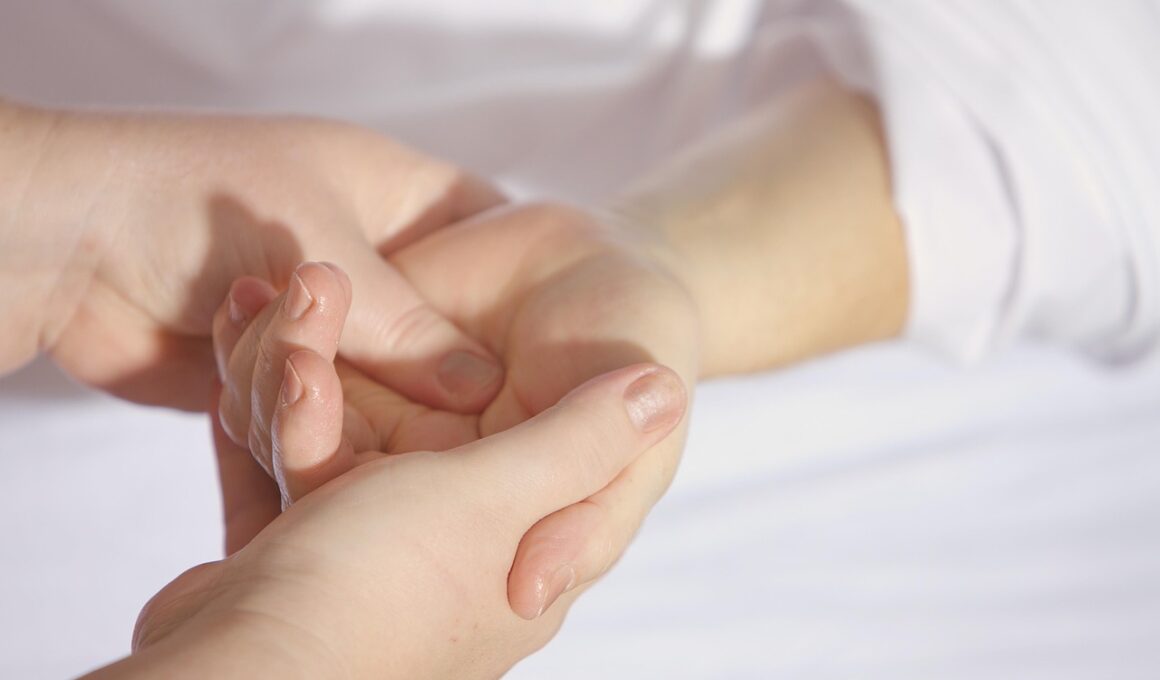Recovery Strategies After a Trail Running Festival
Participating in a trail running festival can be exhilarating and exhausting. It’s crucial to understand how to recover effectively to keep the body in optimal condition. One essential recovery strategy involves proper hydration. After a long day of running across challenging terrains, rehydrating is vital. Aim to consume water and electrolytes. Electrolyte drinks help restore lost minerals essential for maintaining functionality. Additionally, consider nutritional intake. Consuming a meal rich in protein and carbohydrates soon after completing the event helps replenish glycogen stores. Whole foods are excellent choices, such as lean meats, whole grains, fruits, and vegetables. Furthermore, implementing gentle stretches and cool-down routines post-race can aid in decreasing muscle stiffness. Focus on the main muscle groups used during the festival, such as the calves, quads, and hamstrings. Massage therapy can also support recovery by increasing blood flow to muscles. Many athletes find foam rolling beneficial for releasing muscle tension. Lastly, prioritizing rest and sleep during the days following the festival cannot be overstated. Quality rest allows the body to aid recovery, repair tissues, and prepare for future adventures. Don’t overlook these strategies as they contribute significantly to a motivated return.
Incorporating active recovery days into your regimen post-festival is another excellent strategy. Instead of complete rest, light activities like walking, cycling, or swimming can stimulate blood flow without straining the body. These activities enhance circulation and help in reducing muscle soreness. Also, consider taking a warm bath or utilizing contrast baths where hot and cold temperatures alternate. This method boosts circulation and alleviates inflammation. Stretching, yoga, and Pilates can also enhance flexibility and ensure your muscles recover without tightness. It’s essential to listen to your body’s signals during this phase. If you experience pain, decrease the intensity of your activities. Communion with nature can be therapeutic and enjoyable. Spending time outdoors, even on trails, can boost mental health and aid psychological recovery. Moreover, reflecting on the event, jotting down thoughts or feelings about the experience can foster mental clarity and motivation for future endeavors. Engaging with fellow runners in sharing experiences and feelings can create a supportive environment. Lastly, applying ice packs or compression gear can reduce swelling and speed recovery. Remember, recovery is a multifaceted process consisting of physical, nutritional, and psychological aspects.
Nourishment Post-Event
Nourishment plays a central role in recovery after a trail running festival. Initially, it’s fundamental to maintain a balanced diet rich in nutrients. Protein aids in muscle repair, while carbohydrates replenish energy stores. Consider packing a post-race snack. Options like protein bars, Greek yogurt, and smoothies are convenient and effective. Include colorful fruits and vegetables to provide vitamins and antioxidants, assisting in reducing oxidative stress. Furthermore, the timing of your meals matters. Aim to eat within 30-60 minutes of finishing the race. This window is crucial for maximizing recovery. Experimenting with meal options during training can help identify what works for your digestion. Also, don’t forget about hydration. Post-event, continue drinking water or sports drinks to restore electrolytes lost through sweat. This helps prevent cramping and enhances recovery. Moreover, incorporating foods rich in omega-3 fatty acids, like salmon or flaxseeds, can help reduce inflammation. Lastly, using supplements like BCAAs may also accelerate recovery. Always consult with a healthcare provider before starting any new supplements to ensure they are appropriate for your health goals. A balanced approach will enhance your overall recovery experience.
It is essential to pay attention to recovery routines post-trail running festival. Sleep is perhaps the most overlooked aspect of recovery. Aim for restorative sleep as it is during this time that the body repairs itself. Lack of sleep can negatively impact recovery time and performance in subsequent training. Be mindful of creating a restful environment to promote better sleep quality. Techniques like reducing screen time before bed, maintaining a cool room temperature, and creating a bedtime routine can significantly enhance sleep quality. Additionally, mental recovery should not be neglected. Consider mindfulness practices like meditation or deep breathing exercises to relax both mind and body. Fostering a positive mindset towards recovery can motivate you to return stronger. Joining community groups or social media discussions about experiences can bolster the sense of camaraderie among trail runners. Engaging in discussions about lessons learned, celebrating achievements, or sharing recovery tips can be refreshing. Last but not least, track your recovery progress through a journal or app. Monitoring how you feel, the activities you engage in, and your nutrition helps in analyzing what works best for you. Documenting your journey can reinforce commitment to personal growth.
Physical Activities
Physical activities post-trail running festival should be approached with care and consideration. Engage in low-impact exercises that promote blood circulation, helping muscles recover without adding extra strain. Gentle jogging, easy cycling, and swimming provide excellent cardiovascular benefits while being easier on the joints. Incorporate strength training focusing on core stability and flexibility. Functional movements enhance your performance without overworking fatigued muscles. Resistance bands and bodyweight exercises can be effective and safe. Balance training is vital as well, particularly on uneven terrains encountered during trail running. Balance exercises help to mobilize various muscle groups and prevent potential injuries when returning to trail runs. Activities like yoga offer versatility. Not only does it enhance flexibility, but yoga also fosters a mind-body connection, aiding mental recovery. Additionally, incorporating hill walking can serve as a strategy to help strengthen leg muscles while being low-intensity. As you gradually return to higher-paced activities, be conscious of any lingering soreness or tightness in the muscles. This awareness improves the chances of avoiding injuries. Remember, the body needs time to readjust, and guiding your return is crucial in ensuring long-term success.
Before returning to your regular training schedule, consider creating a structured recovery plan tailored to your individual needs. This personalized approach will help you transition smoothly back to active running while staying mindful of your body’s limits. Whether it’s focusing on cross-training, scheduling specific recovery days, or setting goals, having a plan can make all the difference. Mixing in different types of activities will keeps things fresh and minimize boredom, promoting consistency. Moreover, maintaining an open line of communication with coaches or physical therapists can provide additional insights into your plan. They can offer critical feedback on form, running mechanics, and any potential signs of overtraining. Additionally, sharing your recovery experiences with fellow runners can provide encouragement and accountability. It’s also worthwhile to consider attending workshops or clinics focused on recovery strategies. Learning from experts enhances your understanding of effective recovery techniques. Staying connected and involved in the running community keeps motivation alive. Recovery is a journey, not a destination. Each runner has a unique pathway towards recovery; embracing this journey by focusing on health and wellness will ensure future success in trail running adventures. Stay dedicated to your recovery plan and enjoy the benefits.
Final Thoughts
Ultimately, recovery is pivotal in ensuring longevity in the world of trail running. Engaging in various recovery strategies effectively integrates rest and nourishment into the routine. Adequate hydration, nutrition, and mindful practices work synergistically to rejuvenate both body and mind. Assessing each post-festival run experience offers insights into improving future recovery. Incorporate feedback mechanisms, like tracking physical and emotional states, to evolve your recovery process continually. Explore new methods of recovery to find what fits best within your routine. Every runner will have preferences and responses to different techniques; being open to experimentation will yield the best results. Involve in community engagement to foster motivation, support, and shared learning. Building a network of fellow trail runners enhances the recovery experience, stimulating motivation. Make use of recovery days as opportunities for self-care and mental rejuvenation. As you plan your next trail festival, remember that an effective recovery allows you to cherish your trail-running experiences fully. The journey ahead is filled with potential for new adventures. By embracing these recovery strategies, you’re setting the stage for personal growth, improved performance, and, ultimately, more incredible joy derived from running.
In conclusion, recovery shouldn’t be an afterthought; it’s an integral part of the trail running process. A combination of physical, nutritional, and mental strategies creates a robust recovery plan. Make recovery a priority. Enjoy the entire spectrum of trail running experiences, from the exhilarating challenges of the trail festival to the peaceful recovery moments afterwards. Implement these strategies consistently, and you’ll see improvements not only in how you feel after races but also in your performance in future events. With dedication, patience, and awareness, you can transform recovery into a powerful tool that enhances your overall running prowess. Every trail festival you participate in is a stepping stone toward greater achievements in trail running. Celebrate every finish, every moment spent on the trails, and every lesson learned during your recovery. Ultimately, this journey is about more than just running; it’s about the memories created, challenges overcome, and bonds formed with the fellow runners you meet along the way. Stay focused, stay motivated, and enjoy the trails ahead. Let your recovery journey empower you for the adventures yet to come.


